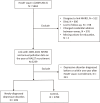The increased risk of exposure to fine particulate matter for depression incidence is mediated by elevated TNF-R1: the Healthy Aging Longitudinal Study
- PMID: 40571594
- PMCID: PMC12206667
- DOI: 10.1265/ehpm.25-00106
The increased risk of exposure to fine particulate matter for depression incidence is mediated by elevated TNF-R1: the Healthy Aging Longitudinal Study
Abstract
Background: Depression among older adults is an important public health issue, and air and noise pollution have been found to contribute to exacerbation of depressive symptoms. This study examined the association of exposure to air and noise pollutants with clinically-newly-diagnosed depressive disorder. The mediating role of individual pro-inflammatory markers was explored.
Methods: We linked National Health Insurance claim data with 2998 healthy community-dwellers aged 55 and above who participated in the Healthy Aging Longitudinal Study between 2009 and 2013. Newly diagnosed depressive disorder was identified using diagnostic codes from the medical claim data. Pollutants were estimated using nationwide land use regression, including PM2.5 and PM10, carbon monoxide, ozone, nitrogen dioxide, sulfur dioxide, and road traffic noise. Cox proportional hazard models were employed to examine the association between pollutants and newly developed depressive disorders. The mediating effect of serum pro-inflammatory biomarkers on the relationship was examined.
Results: Among the 2998 participants, 209 had newly diagnosed depressive disorders. In adjusted Cox proportional hazard models, one interquartile range increase in PM2.5 (8.53 µg/m3) was associated with a 17.5% increased hazard of developing depressive disorders. Other air pollutants and road traffic noise were not linearly associated with depressive disorder incidence. Levels of serum tumor necrosis factor receptor 1 mediated the relationship between PM2.5 and survival time to newly onset depressive disorder.
Conclusion: PM2.5 is related to an increased risk of newly developed depressive disorder among middle-aged and older adults, and the association is partially mediated by the pro-inflammatory marker TNF-R1.
Keywords: Air pollution; Inflammation; Mental health; Particulate matter; Road traffic noise.
Conflict of interest statement
The authors declare that they have no competing interests.
Figures
Similar articles
-
Association of metabolic signatures of air pollution with MASLD: Observational and Mendelian randomization study.J Hepatol. 2025 Apr;82(4):560-570. doi: 10.1016/j.jhep.2024.09.033. Epub 2024 Sep 28. J Hepatol. 2025. PMID: 39349253
-
Association of short-term exposure to air pollutants with mortality from respiratory diseases: a case-crossover study of individual cases based in Hefei, China.J Glob Health. 2025 Jun 27;15:04196. doi: 10.7189/jogh.15.04196. J Glob Health. 2025. PMID: 40570205 Free PMC article.
-
Long-term exposure to air pollution and incident Alzheimer's disease among older adults: evidence from a large-scale retrospective cohort in Korea.Environ Sci Pollut Res Int. 2025 Jun;32(30):18349-18365. doi: 10.1007/s11356-025-36723-7. Epub 2025 Jul 18. Environ Sci Pollut Res Int. 2025. PMID: 40679683
-
Association Between Environmental Air Pollution and Thyroid Cancer and Nodules: A Systematic Review.Thyroid. 2024 Dec;34(12):1451-1464. doi: 10.1089/thy.2024.0317. Epub 2024 Nov 18. Thyroid. 2024. PMID: 39552469
-
The impact of short-term exposure to air pollutants on the onset of out-of-hospital cardiac arrest: A systematic review and meta-analysis.Int J Cardiol. 2017 Jan 1;226:110-117. doi: 10.1016/j.ijcard.2016.10.053. Epub 2016 Oct 25. Int J Cardiol. 2017. PMID: 27806308
References
-
- Organization WH. Mental health action plan: 2013–2020. 2013.
-
- Alexopoulos GS. Depression in the elderly. Lancet. 2005;365(9475):1961–70. - PubMed
-
- Buoli M, Grassi S, Caldiroli A, Carnevali GS, Mucci F, Iodice S, et al. Is there a link between air pollution and mental disorders? Environ Int. 2018;118:154–68. - PubMed
-
- Gu X, Liu Q, Deng F, Wang X, Lin H, Guo X, et al. Association between particulate matter air pollution and risk of depression and suicide: systematic review and meta-analysis. Br J Psychiatry. 2019;215(2):456–67. - PubMed



